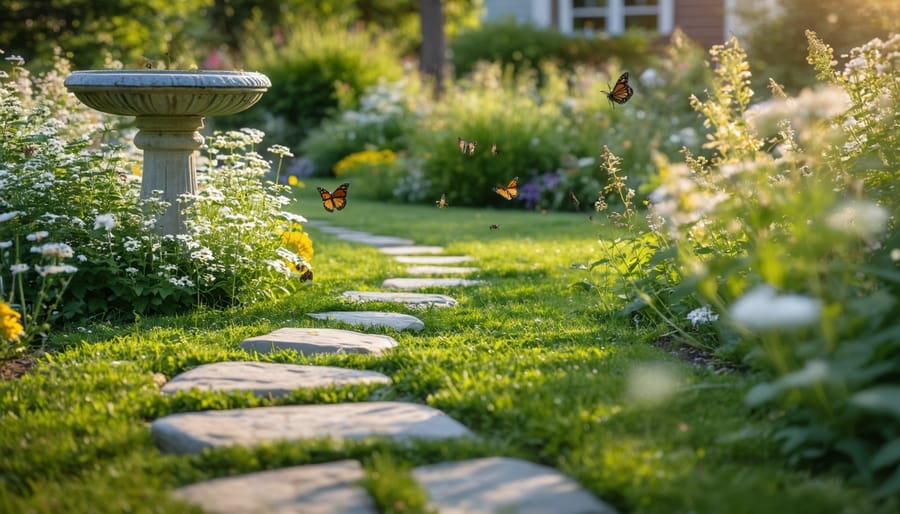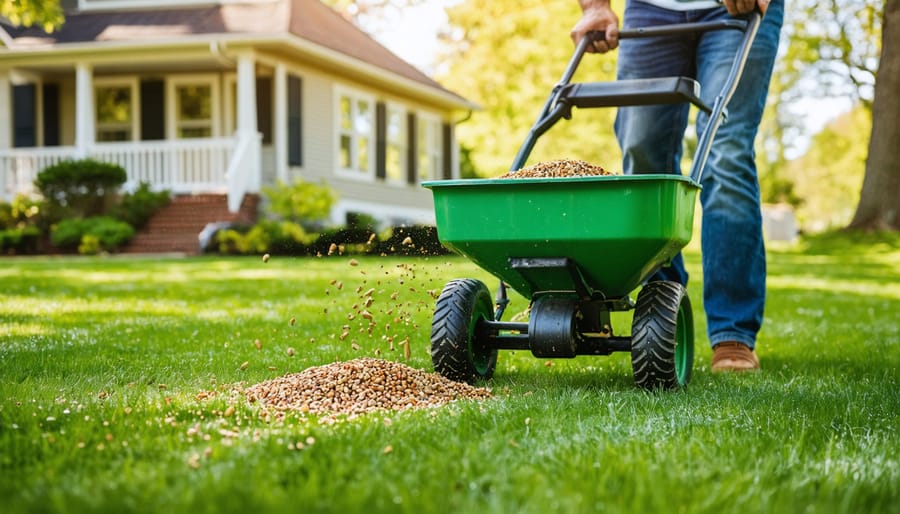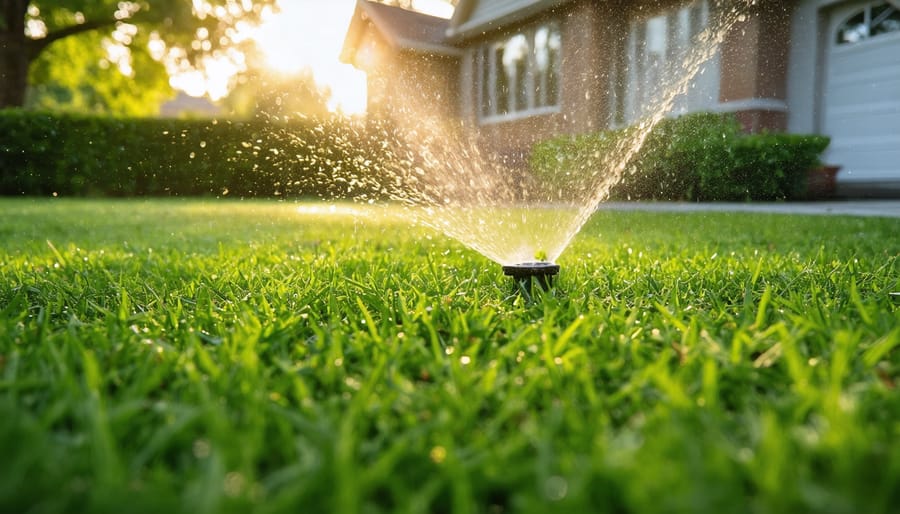Transform your lawn into a pollinator haven by letting designated areas grow to at least six inches before mowing, creating shelter and food sources for native bees and butterflies. Replace 20-30% of your traditional turf with native wildflower patches that require zero fertilizer and minimal watering once established, reducing your maintenance time while supporting local ecosystems.
Create mowing paths through taller sections using a mulching mower set to its highest setting, leaving grass clippings to decompose naturally and return nitrogen to the soil. This eliminates bagging waste and cuts fertilizer needs by up to 25%. Install shallow water sources like birdbaths with stones for landing spots, positioning them near flower clusters to support pollinators during hot months.
Plant in irregular drifts rather than rows, mimicking natural meadow patterns that pollinators navigate instinctively. Choose regionally appropriate species that bloom in succession from early spring through fall, ensuring continuous food availability. White clover makes an excellent lawn alternative that stays green during drought, fixes nitrogen naturally, and provides abundant flowers that bees visit throughout summer.
Eliminate pesticides entirely by embracing beneficial insects like ladybugs and lacewings that control aphids and other pests naturally. Tolerate minor imperfections in your lawn, recognizing that small weeds like violets and dandelions offer critical early-season nutrition when little else blooms. This mindset shift from pristine monoculture to biodiverse landscape represents the foundation of truly sustainable landscaping, creating outdoor spaces that work with nature rather than against it while reducing your workload and environmental footprint simultaneously.
Why Your Lawn Matters More Than You Think
Your lawn might look perfectly manicured, but here’s something most homeowners don’t realize: that pristine green carpet could be contributing to one of the most critical environmental challenges we’re facing today. We’re in the midst of a pollinator crisis, and the numbers are sobering. Bee populations have declined by nearly 40% in recent years, and other beneficial insects are facing similar threats. While this might seem like a distant environmental issue, the solution is quite literally in your own backyard.
Here’s the surprising part: residential landscapes collectively cover more area than all our national parks combined. That means your lawn care decisions, multiplied across millions of homes, have an enormous impact on local ecosystems. When you think about it that way, every property becomes a potential sanctuary or a dead zone for the creatures that pollinate a third of the food we eat.
The problem with traditional lawn care practices goes beyond just lack of flowers. Chemical fertilizers and pesticides don’t just target weeds and pests, they harm beneficial insects too. Frequent mowing eliminates crucial food sources before they can bloom, while non-native grass monocultures offer virtually nothing to local pollinators. Even the timing of your mowing can disrupt nesting insects that burrow in soil or hollow stems.
But here’s the encouraging news: small changes to your lawn care routine can make a tremendous difference. You don’t need to abandon your lawn entirely or let your yard become overgrown. By adjusting your approach to landscaping, you can maintain an attractive outdoor space while creating vital habitat for pollinators. The key is understanding that a healthy lawn doesn’t have to mean a sterile one. In fact, the most resilient, low-maintenance lawns often incorporate diversity and work with nature rather than against it.

Rethinking the Perfect Lawn: What Pollinators Actually Need
For generations, we’ve been conditioned to believe that the perfect lawn means uniform, weed-free grass cut to putting-green precision. But here’s the truth: that manicured monoculture is essentially a green desert for the pollinators our ecosystem desperately needs. It’s time to rethink what “perfect” really means.
The conventional lawn offers pollinators virtually nothing. Without diverse flowering plants, bees, butterflies, and other beneficial insects find no food sources. Without varied heights and textures, they lack shelter and nesting sites. Yet transforming your landscape into a pollinator haven doesn’t mean abandoning all sense of order or letting your yard become an impenetrable jungle.
What pollinators actually need is surprisingly simple: diversity, food sources throughout the growing season, and chemical-free spaces. This means incorporating native flowering plants that bloom at different times, allowing some areas to grow a bit wilder, and creating layered landscapes with varying heights. Even small changes make a significant difference.
Think of your lawn as a living ecosystem rather than an ornamental carpet. A pollinator-friendly landscape can still look intentional and attractive. You might maintain traditional turf in high-traffic areas while converting border zones into flowering meadows. Consider leaving clover in your grass or reducing mowing frequency in certain sections to allow dandelions and violets to bloom.
The beauty of sustainable landscaping is that it works with nature, not against it. You’ll spend less time fighting weeds, use fewer resources, and create genuine environmental value. Plus, there’s something deeply satisfying about watching bees visit flowers you’ve planted or spotting butterflies that now call your yard home. This shift in perspective transforms lawn care from a chore into an act of environmental stewardship, one that benefits both your local ecosystem and your own peace of mind.
Plant Selection: Creating a Pollinator Buffet
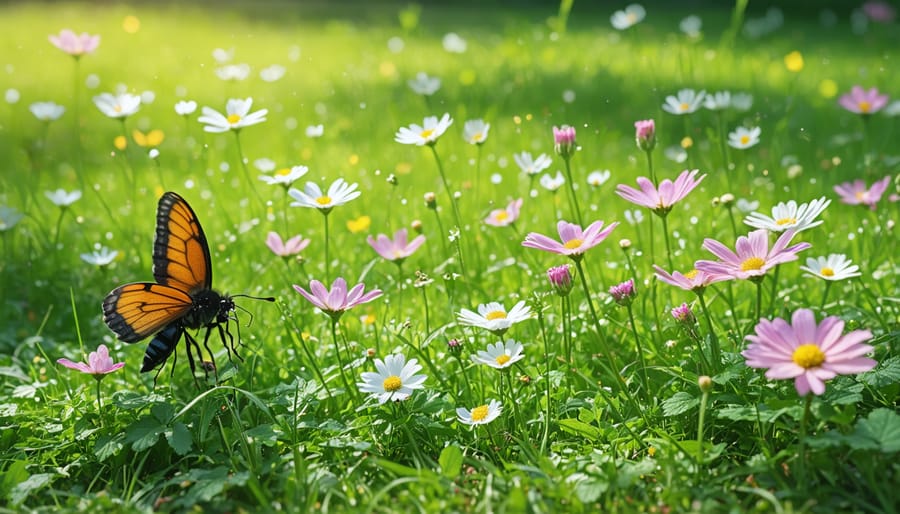
Native Plants: Your Secret Weapon
Here’s your secret weapon for creating a thriving pollinator paradise: native plants. These locally adapted species have evolved alongside regional pollinators for thousands of years, creating perfectly matched partnerships that non-native ornamentals simply can’t replicate.
Native plants offer nectar and pollen profiles that local bees, butterflies, and hummingbirds instinctively recognize and prefer. They also require significantly less water and maintenance once established, since they’re already adapted to your area’s soil and climate conditions. That means less mowing, less watering, and more time enjoying your beautiful landscape.
Finding natives for your region is easier than you might think. Start with your local native plant society or cooperative extension office, which typically provides free plant lists organized by sun exposure and moisture needs. The Lady Bird Johnson Wildflower Center’s database is another excellent resource for searching by zip code.
For the Northeast, try purple coneflower and black-eyed Susan, both beloved by butterflies and incredibly low-maintenance. Midwest gardeners should consider prairie dropseed grass and wild bergamot. In the Southeast, coralberry and Carolina jessamine attract hummingbirds year-round. Western regions thrive with California poppy and penstemon varieties.
The beauty of native plants is their resilience. Unlike fussy exotic species, they practically take care of themselves while providing maximum benefit to local wildlife. It’s truly a win-win situation for you and your pollinator friends.
Blooming Through the Seasons
Creating a garden that feeds pollinators throughout the growing season is like setting out a continuous buffet for your beneficial guests. The secret lies in thoughtful succession planting, ensuring that as one flower fades, another takes its place.
Start your season with early bloomers like crocuses, wild violets, and native fruit trees, which provide crucial nutrition when pollinators first emerge from winter dormancy. These early risers can mean the difference between life and death for hungry bees emerging from hibernation.
As spring transitions to summer, introduce mid-season champions such as coneflowers, black-eyed Susans, and bee balm. These powerhouse perennials not only offer abundant nectar but also require minimal maintenance once established. Here’s where sustainable practices really shine: native plants naturally bloom in sequence, having evolved alongside local pollinators over thousands of years.
For fall, extend the feast with asters, goldenrod, and sedum. These late-season bloomers help pollinators build energy reserves for winter or migration. When planning your beds, aim for at least three different species blooming during each season.
A practical tip: keep a simple garden journal noting when each plant blooms in your specific microclimate. This helps you identify gaps in coverage and adjust accordingly next season, creating an increasingly efficient pollinator paradise year after year.
Beyond Flowers: Herbs, Grasses, and Ground Covers
While traditional flowers are wonderful, don’t overlook the pollinator power of herbs, grasses, and ground covers. These hardworking alternatives offer nectar and pollen while serving multiple functions in your landscape.
Flowering herbs like thyme, oregano, lavender, and catmint are absolute pollinator magnets. Let a portion of your herb garden go to flower rather than constantly harvesting, and you’ll witness bees working tirelessly throughout the blooms. These plants thrive in sunny spots, require minimal water once established, and bonus: you get fresh herbs for your kitchen. Sage, borage, and chives are equally beloved by pollinators and incredibly easy to grow.
Ornamental grasses might not seem like obvious pollinator plants, but native varieties like little bluestem and switchgrass provide essential shelter and nesting materials for beneficial insects. They also add movement and texture to your landscape while requiring practically zero maintenance.
Ground covers present the most exciting opportunity to replace traditional turf. Creeping thyme transforms into a fragrant, flowering carpet that tolerates light foot traffic. Dutch white clover fixes nitrogen in your soil while providing continuous blooms for bees. Both options stay low, require no mowing, and remain green through drought conditions. For shadier areas, consider sweet woodruff or wild ginger, which create dense, weed-suppressing mats while supporting ground-dwelling pollinators.
Sustainable Mowing Strategies That Support Pollinators

The Magic of Mowing Higher
Here’s a game-changing tip that seems almost too simple: raise your mower blade height, and you’ll transform your lawn into a pollinator paradise while improving grass health. Most homeowners cut their grass way too short, scalping it down to an inch or two. This stresses the grass and eliminates valuable habitat for ground-nesting bees and other beneficial insects.
The sweet spot for sustainable mowing is keeping your grass between 3 to 4 inches tall. At this height, grass develops deeper root systems, which means it naturally resists drought, crowds out weeds, and requires less fertilizer. You’re essentially creating a self-sustaining ecosystem with one simple adjustment.
Taller grass also provides crucial shelter for pollinators between flowering plants. Those extra inches create shaded microclimates where insects can rest and nest, particularly important during hot summer months.
To adjust your mower height, locate the adjustment lever near each wheel. Start by measuring your current cutting height with a ruler, then gradually increase it over several mowings. Your grass needs time to adapt, so don’t jump from 2 inches to 4 inches overnight. Most riders find the highest or second-highest setting works perfectly for pollinator-friendly lawns while still maintaining that manicured appearance.
Strategic Mowing Schedules
Timing your mowing schedule strategically can make all the difference for pollinators without sacrificing a tidy-looking lawn. Think of it as giving your lawn flowers a chance to shine before the mower comes through.
For clover lawns and mixed turf that naturally include flowering plants like dandelions, white clover, and violets, consider adopting a “high mow, mow less” approach. Instead of the traditional weekly cut, extend your mowing interval to every 10-14 days during peak blooming seasons in spring and early summer. This gives flowers time to complete their bloom cycle, allowing bees and butterflies adequate feeding opportunities.
The height you mow matters too. Set your mower deck to at least 3-4 inches, which protects flower stems and encourages deeper root systems that naturally outcompete weeds. Many pollinator-friendly flowers, particularly clover, bloom close to the ground and can still provide nectar even after a higher cut.
Here’s a practical compromise that works beautifully: create zones in your yard with different mowing schedules. Keep high-traffic areas near pathways and patios on your regular schedule, while designating low-use sections as “pollinator patches” that get mowed monthly or even less frequently.
Consider seasonal adjustments as well. During late spring when dandelions peak, delay mowing an extra few days to maximize their benefit. In fall, reduce mowing frequency altogether as many lawns naturally slow their growth and fewer flowers are present. This flexible approach respects both your lawn’s appearance and the creatures depending on it for survival.
Ditching the Chemicals: Organic Lawn Care for Pollinator Safety
Natural Pest Control Solutions
Managing pests naturally doesn’t mean sacrificing a healthy lawn. The key is working with nature rather than against it, creating a balanced ecosystem where beneficial insects help keep problem populations in check.
Start with companion planting, one of the easiest organic pest control methods. Marigolds naturally repel aphids and mosquitoes, while lavender deters moths and fleas. Plant these around your lawn’s borders or integrate them into garden beds adjacent to your grass. I’ve found that yarrow and clover mixed into lawns actually attract ladybugs and ground beetles, which feast on common lawn pests like chinch bugs and grubs.
Encourage biological controls by welcoming pest predators. Birds are excellent allies, consuming thousands of insects daily. Add birdbaths and native shrubs to attract them. For grub problems, consider applying beneficial nematodes, microscopic organisms that target pest larvae without harming earthworms or pollinators. They’re available at most garden centers and work remarkably well when soil conditions are right.
Maintain healthy soil through composting and proper mowing height. Strong, vigorous grass naturally resists pest damage better than stressed lawns. Sometimes the best pest control is simply creating conditions where your lawn can defend itself. When you notice pest activity, give beneficial insects a week or two to respond before intervening. Nature often solves these problems faster than we expect.
Embracing ‘Weeds’ That Feed Pollinators
Let’s be honest: we’ve been taught to wage war against some of nature’s most valuable plants. Those dandelions dotting your lawn? They’re actually an early-season lifeline for bees emerging from winter. That clover spreading through your grass? It’s a nitrogen-fixing powerhouse that feeds both pollinators and your soil.
The shift here isn’t about letting your yard become a tangled mess. It’s about intentionally welcoming these hardworking plants as partners in your landscape. When you stop fighting clover, dandelions, and violets, something remarkable happens: you reduce maintenance work while creating vital pollinator habitat. Plus, you’ll spend less time and money on weed control products that harm beneficial insects.
Start by identifying which lawn weeds actually benefit pollinators. White clover produces nectar-rich blooms that bees adore, while its roots improve soil health. Dandelions flower when little else does, providing critical early nutrition. Wild violets offer both nectar and serve as host plants for fritillary butterfly caterpillars.
The practical approach? Designate mixed zones where these plants can thrive alongside turfgrass. Adjust your mowing height to 3-4 inches and mow less frequently during peak bloom periods, giving flowers time to feed pollinators before cutting. You can even overseed thin areas with microclover varieties that stay low and green.
This isn’t about abandoning lawn care standards. It’s about redefining them to include ecological value. Your neighbors might raise eyebrows initially, but when they see butterflies dancing through your yard and your reduced maintenance schedule, they’ll start asking questions.
Creating Pollinator Habitats Beyond Flowers
Water Features for Thirsty Pollinators
Pollinators need water just like they need nectar, but a deep birdbath or pond can be a drowning hazard for these tiny visitors. The good news? Creating safe water sources is incredibly simple and costs next to nothing.
Start with shallow dishes filled with clean water—terracotta saucers work beautifully. Add pebbles, marbles, or small stones to create landing pads where bees and butterflies can perch safely while drinking. Think of it as a pollinator pool party with plenty of “floaties” for safety!
Place these watering stations throughout your garden, especially near flowering areas where pollinators are already working hard. During hot summer months, refresh the water daily to prevent mosquito breeding and keep it clean.
For a more permanent solution, consider a shallow depression in your landscape filled with gravel and kept slightly moist. This mimics natural puddles that butterflies particularly love for “puddling”—gathering moisture and essential minerals. Even a dripping faucet over stones can attract thirsty visitors. These small efforts make a big difference, transforming your sustainable landscape into a true pollinator oasis.
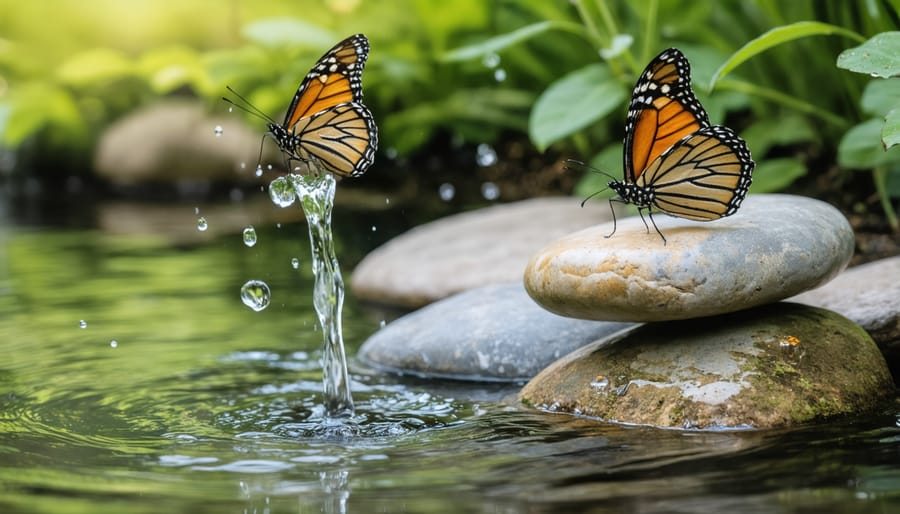
Nesting Sites: Where the Magic Happens
Creating welcoming nesting spaces is just as important as planting flowers. Many native bees are ground-nesters, so consider leaving small patches of bare, undisturbed soil in sunny spots throughout your yard. These areas don’t need to be large—even a square foot can host several bee nests. Resist the urge to mulch every inch of your garden beds.
For cavity-nesting bees like mason bees and leafcutter bees, drill holes of varying diameters (between 3/32 and 3/8 inches) into untreated wooden blocks or purchase bee houses. Place them in protected areas facing southeast, about three to five feet off the ground. Leave hollow plant stems standing through winter rather than cutting everything back in fall—these provide natural nesting tubes.
Create brush piles with twigs and branches for other beneficial insects. The key is embracing a little messiness. That “perfectly manicured” look often means fewer homes for pollinators. By designating wildlife-friendly zones in your landscape, you’re building an entire ecosystem, not just a pretty garden.
Leave the Leaves (At Least Some of Them)
That pristine fall cleanup might look tidy, but it’s actually evicting important garden guests. Many native bees, butterflies, and beneficial insects overwinter in hollow plant stems, leaf litter, and seed heads. When we rake everything bare, we’re essentially destroying their winter homes.
Here’s a sustainable compromise: Leave leaf piles in garden beds and around the base of trees where they act as natural mulch, insulating plant roots and providing habitat. Instead of cutting perennials to the ground, leave stems standing at least 12-18 inches tall through winter. These hollow stalks house solitary bee larvae and other pollinators until spring warmth signals their emergence.
If you prefer tidier lawn areas, rake leaves into designated wildlife zones rather than bagging them for disposal. This approach aligns perfectly with sustainable mulching practices while creating essential habitat. Come spring, you can clean up spent materials once temperatures consistently reach 50 degrees Fahrenheit, giving overwintering insects time to emerge safely.
Tools and Equipment That Support Your Eco-Friendly Goals
Making the switch to eco-friendly lawn care equipment doesn’t mean sacrificing efficiency or results. In fact, many sustainable tools outperform their gas-guzzling counterparts while supporting your pollinator-friendly landscape goals.
Let’s start with the backbone of sustainable lawn maintenance: electric and battery-powered mowers. Modern cordless electric mowers have come a long way, offering impressive runtime and cutting power without the noise, emissions, or maintenance headaches of gas models. Look for models with adjustable cutting heights above three inches to support your pollinator meadow areas. The EGO Power+ and Greenworks lines consistently receive high marks for reliability and performance.
For those transitioning to lower-maintenance landscapes with diverse plantings, a quality string trimmer becomes essential. Battery-powered trimmers allow you to edge around wildflower patches and native plant borders without the fumes that can stress beneficial insects. I’ve found that models with variable speed controls give you the precision needed when working near delicate pollinator plants.
Don’t overlook the power of manual tools for smaller spaces or detailed work. A sharp pair of hand pruners, a quality garden fork, and a traditional push reel mower for small lawns eliminate emissions entirely while providing excellent exercise. Corona and Felco make professional-grade hand tools that last for decades with proper care.
Consider investing in a quality soil knife or hori-hori for planting native species and dividing perennials. This single tool replaces multiple implements and causes minimal soil disturbance, protecting underground-nesting bees.
For watering needs, soaker hoses and drip irrigation systems deliver moisture directly to plant roots, reducing waste and keeping flower heads dry for visiting pollinators. Rain barrels complement these systems perfectly, harvesting free water while reducing runoff.
Remember, the most sustainable tool is one that lasts. Choose quality over quantity, maintain your equipment properly, and you’ll support both your budget and environmental goals for years to come.
Starting Small: Your First Steps Toward a Pollinator Paradise
You don’t need to transform your entire yard overnight to make a meaningful difference for pollinators. In fact, starting small often leads to more sustainable, manageable changes that actually stick.
Begin by identifying just one area of your lawn, perhaps a corner plot or a section along your fence line, that you’ll convert into pollinator habitat. This could be as modest as a 3×3 foot patch or as ambitious as a 10×20 foot border. Choose a spot that receives at least six hours of sunlight daily, as most pollinator-friendly plants thrive in full sun.
Your first season is about learning, not perfection. Start by reducing mowing frequency in your chosen area. Let the grass grow a bit taller and allow any existing clover or wildflowers to bloom. You might be surprised at what’s already there waiting to support pollinators. If you spot dandelions, resist the urge to pull them immediately. They’re actually early-season food sources for bees emerging from hibernation.
Next, add three to five native plant species to your test plot. Visit a local native plant nursery and ask about beginner-friendly perennials suited to your region. Look for plants with different bloom times to provide nectar throughout the growing season. Don’t worry about creating an elaborate design. Simple clusters of the same plant species actually make it easier for pollinators to find food.
Within the first month, you’ll likely notice increased butterfly and bee activity. By the end of your first growing season, you’ll have learned which plants thrive in your specific conditions and gained confidence to expand. Remember, every pollinator garden started with a single plant and a willingness to try something new.
Every small change you make in your lawn care routine creates ripples that extend far beyond your property line. When you mow a little higher, let a patch of clover flourish, or plant a cluster of native wildflowers, you’re not just beautifying your space—you’re building vital infrastructure for struggling pollinator populations. These creatures need our help more than ever, and your yard can be part of the solution.
The beauty of pollinator-friendly landscaping is that it rewards you as much as it helps the environment. Picture stepping outside to a lawn alive with the gentle hum of bees moving between flowers, butterflies dancing across blooming sections, and the satisfaction of knowing you’ve created something truly meaningful. These landscapes often require less maintenance than traditional lawns once established, saving you time, money, and effort while providing far more visual interest throughout the seasons.
You don’t need to transform your entire property overnight. Start with one corner, experiment with reducing mowing frequency in a small area, or simply raise your mower blade height on your next cut. Each step builds confidence and shows you what works for your specific conditions. As you see pollinators visiting and your landscape evolving, you’ll likely find yourself eager to expand your efforts.
Your lawn care choices matter. The collective impact of thousands of yards becoming pollinator havens can genuinely shift local ecosystems toward recovery. You have the power to make that difference, starting today.
